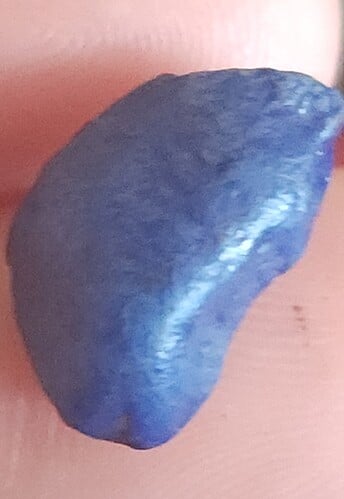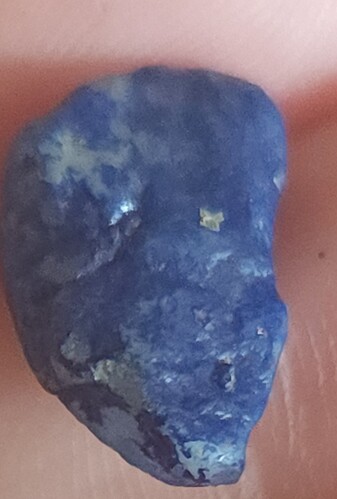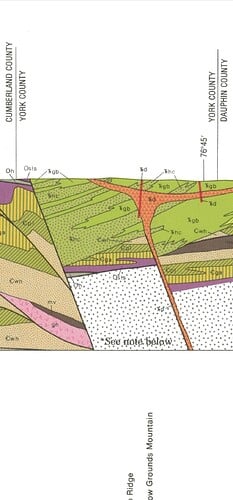So I have been trying to get my sapphire source rechnized for going on 2 years now with no one willing To take the time to hear me out. I am now going to basically say screw it and i am working to get into a geology journal with 3 new separate reports.
But in the meantime I do still need to raise money for the adoption of the two covid orphns in India I have fallen in love with. I have a trade show in about 6 weeks. And while i don’t want to part with my brilliant transparent unheated sapphires yet i have no problem selling some of my stunning opaque sapphires.
My problem is in knowing the value.
Can any advise on how much per ct a untreated sapphire should be priced for when it is not transparent. I literally have thousands.
Thanks for your help and advice.
If not transparent they are only suitable as specimens of blue corundum. If large they can be carved and skin polished or made into beads. Otherwise, they are the same as any interesting geological material and have no or little gem value.
Also I am still looking for a number per ct. I have seen similar sold for $5 - 500 the variation is frustrating.
Its really important that I not compromise on the price because it all is going to be “sold” as a donation. I’m raising money to go to India and adopt 2 orphans who have waited over a tear for me to get there.
these are guaranteed never treated!!
No heat ever!
I dug these out with my own hands from my own yard.
Plant some veggies in those holes in your back yard.
2 Likes
Hello ElizabethM,
You can do a specific gravity determination which will give you a debating point with anyone who doesn’t believe you because corundum is so different in “heft” in the hand to anyone who has had some experience with gems and minerals and because its specific gravity is so much higher than most other gems and minerals. Just look at my reply to the recent post titled “Identification help,” for the procedure.
I’m sorry to have to say this, but it is unlikely that your red piece is corundum…the color is too-good-to-be-true and the top in your picture is too flat to be as-found corundum and it is rather transparent. A piece of ruby like that would be worth a lot of money as a cab or faceted and odds are someone else in your area would have found a specimen years ago and reported it. But the SG will tell you whether it is glass, quartz, something else or corundum.
As far as the price for opaque corundum, it is very low compared to the price for translucent star corundum or transparent, facet grade corundum, but you could start by looking for opaque cabs for sale on the internet on retail sites. Once you estabish a modal retail price, then you can back into a wholesale price and from there into a price for the rough. I don’t think you will have trouble finding someone who cabs who could polish cabs for you. There is also a mineral collectors market for massive corundum for collections and for carvings, so you could, once you have an authentication, look for forums and websites of collectors and lapidaries who might be interested if your specimens are larger than what someone would cab for sale in jewelry. Bear in mind that opaque cabs are worth less than transparent stones and mottled colored stones are worth less than stones that are a uniform blue throughout. From what I can see in your pictures, your large stone is opaque and mottled. You can search until you find images of stones like those. I can’t say anything more, because I don’t see any size or weight referenced. I hope this is helpful and bear in mind that it is my opinion only, just after viewing a few photos. Other people may see the situation differently. Good luck in your seach! -royjohn
That red was under sw black light. But yes i can try to do the Sg but my scales are not dependable.
Others do find it and assume its glass te red is rare to find more common is colorless, green 3 shades, a brown/red 2 shades, and blue 4 shades include a teal and a type that is only transparent from some directions.
But it has a clear and definite crystline structure. The geological survey in this area was estimated because of interference with the tests. The surface evaluation was 2%cambrian metamorphic and that would be an appropriate amount for what would have been exposed at that timemy atea wasnt developef till the late 40s and the ground is notoriously impossibly hard. We have a conical structure nearby with lines going east and west west goes under my neighborhood the east goes to a impossibly deep lake that was dredged for iron in some of the earliest mines whos sorce is still unknown (Lake Grubb) Magnitite Limonite native copper, pyrite, platinum, gold, chromium…and much more on top of that im on the edge of the great magnesium sheet with basalt and dolomite
(so that implies it was under sea water when it was changed) this area hasn’t been under water like that since 570-400million years ago .
I have done my reasurch and I am NOT an idiot i habe been dedicated to learning as much as possible and collectin HUNDRED OF POUNDS of samples
I found micro diamonds and because i dot trust my cheep scales or my temperature diamond testers that shoot off of the scales. i do mostly hardness and chemical tests
I can soak these in pure vinegar with no damage not that i do regularly I usually dilute it with water 2:1 or 1:1 i have a microscope i have verified details on and they scratch emeralds but yeah ill do a sg and again.
Everything about it screems hydrothermal vent but because I am a girl with no degree no one is listening or willing to look at my stones in person. I have even offered to ship them. Pcpg was going to test them but i embarrassed the testing department when it took 2 months for him to NOT read my email and send an insulting form letter so u was blocked ny their social media coordinator and the president of the organization never responded.
1 Like
But yeah im here trying to learn as much as I can for a simple scam and a few bucks. Im disablef , autistic, chronically ill and all i want is to raise $3000 to fly to India and adopt 2 covid orphans living in a youth hostel in Ghazipur Uttar Pradesh India who i can’t even bring back to the states with me and I would only be able to see them and my husband if im lucky for 3 months of the year
I can send a million more photos of what i have been sorting for 2years and maybe get 1 nore person to say ok maybe but…
Ut whats the point its gotten me NO WHERE, NOTHING, Ignored, mocked, belittled, teased in front of my face thinking im too stupid to get the joke. I have a 130iq spatial thinking a passion for science and all the time in the world. But what could possibly have done to be this lucky … NOTHING!!!
I was just the first to look at the damn “*”
Thanks thats really helpful
1 stone vs emerald
Pardon my verbal slip ups it’s 4:30 am heres a video of 1 stones hardness vs emerald
Im honestly looking for assistance i can only go on what i know so far.
Yep … nothing at least im no longer shocked about being ignored…
Streak test impossible they scratch the ceramic plates
Hi Elizabeth this Emanuel Nyahoegems@gmail.com try this sell your gemstones is a hard task without laboratory support To assess and verify the quality and authenticity of untreated opaque blue sapphires with white matrix spots, several gemological tests and evaluations can be performed. Here’s a breakdown of these tests:
- Visual Inspection:
- Color and Clarity: Examine the stone under various lighting conditions to assess its color saturation, hue, and any inclusions or white matrix spots.
- Surface Characteristics: Look for any surface blemishes, cracks, or irregularities that might affect the stone’s durability and aesthetic appeal.
- Magnification:
- Gem Loupe: Use a 10x gemological loupe to inspect the stone for inclusions, fractures, and the nature of the white matrix spots.
- Microscope: A gemological microscope can provide a more detailed view of internal features and inclusions, helping to identify natural versus synthetic characteristics.
- Refractometer Test:
- Refractive Index (RI): Measure the refractive index of the sapphire. Natural blue sapphires have an RI of approximately 1.76 to 1.77. This test helps differentiate sapphires from other similar-looking stones.
-
Specific Gravity Test:
- Density Measurement: Blue sapphires typically have a specific gravity of around 4.00. This can be measured using a hydrostatic balance.
-
Spectroscope Analysis:
- Light Absorption Patterns: Use a spectroscope to examine the light absorption spectrum of the sapphire. Natural sapphires show characteristic absorption lines that can help confirm their authenticity.
-
UV Light Test:
- Fluorescence: Observe the stone under ultraviolet (UV) light to check for fluorescence. Most natural sapphires do not fluoresce, but some treated sapphires might show different patterns.
-
Inclusion Analysis:
- Type of Inclusions: Identify the type of inclusions present. Natural sapphires often have needle-like inclusions, while synthetic ones may show gas bubbles or curved striae.
-
Advanced Gemological Tests:
- Raman Spectroscopy: This non-destructive test can provide precise information about the stone’s molecular structure.
- Fourier Transform Infrared Spectroscopy (FTIR): Used to detect the presence of treatments like heat or surface diffusion.
-
Certification:
- Gemological Laboratories: Submit the sapphire to a reputable gemological laboratory (e.g., GIA, AGS, IGI) for comprehensive testing and certification. The lab report will include details about the stone’s characteristics, treatments, and authenticity.
Summary:
These tests collectively help in assessing the quality, authenticity, and potential treatments of blue sapphires with white matrix spots. Visual and magnification inspections, coupled with advanced spectroscopic and laboratory analyses, provide a thorough evaluation of the gemstone.
For more detailed procedures and examples, you can refer to sources such as Gemval, The Natural Sapphire Company, and Gemdaia Jewellery.
Hopefully this will help i’m sorry to hear are your so frustrated, but it is not easy to sell gemstones,
God bless you keep trying
Emanuel; nyahoegems@gmail.com
Subject: Certified Gemologist Services
Dear Elizabeth,
I hope this message finds you well. I wanted to apologize for any delay in communication. I’m excited to inform you that I have recently completed my certification as a gemologist, including all relevant mini-courses.
As a certified gemologist based in London, England, I’m now well-equipped to assist you with any gemological needs you may have. Please feel free to reach out to me at nyahoegems@gmail.com for any inquiries or assistance.
Kind regards,
Emanuel
1 Like
I emailed you but yes i would love to work with you.
Blessings be upon you and yours for 7 gennerations to come.




Autumn Rose
Hi Elizabeth,
Sorry for the delayed response—I’ve been busy studying and then taking some time to relax after finishing the gemologist course. I hope you’re doing well! If I’ve missed any of your emails, I apologize. Please feel free to let me know if there’s anything you need from me
Best wishes Emanuel Nyahoe








